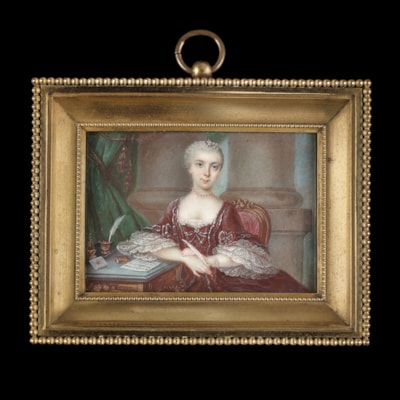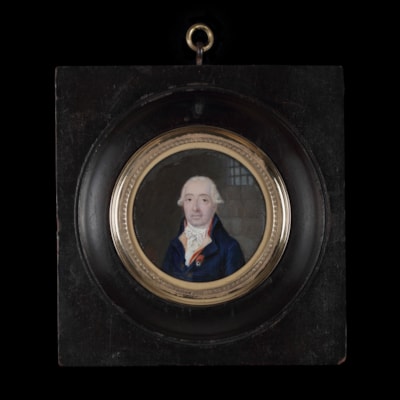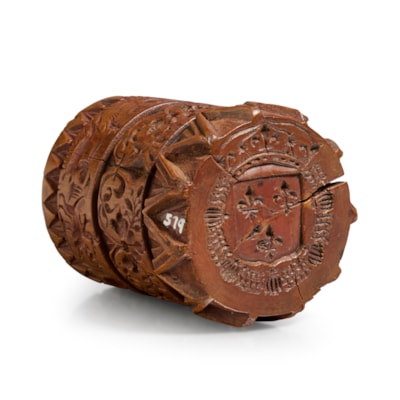FRENCH SCHOOL (18th century)
Portrait miniature of a Young Lady in a blue redingote and yellow waistcoat, with flounced collar and striped cravat
Circa 1790s
Watercolour on ivory (licence number: 2SUQVHNB)
Set into a vari-coloured snuff box with gold decoration and tortoiseshell interior.
Circular, 62mm diameter.
SOLD
Women throughout Western Europe in the late eighteenth century began to adopt jackets like that worn in this portrait, known as redingotes. These were inspired by the riding coats worn by their male contemporaries, and often featured wide collars and lapels. As is the case here, these were worn over corsets and with a separate skirt, and the jacket itself featured a skirt, but only on the reverse of the garment. In this portrait, the sitter's bust is adorned with a light, flounced collar and a cravat. This cravat is the only decorated or patterned item within her outfit, and it is possible that it was included to ensure that she was wearing all the colours of the tricolore. Doing so was important as one could be accused of not supporting the revolutionary cause if this visual display of loyalty was not apparent.
There are other key examples of women wearing these styles. Interestingly, one of these comes from a portrait, not of a revolutionary, but of Marie Antoinette herself. A portrait of the queen, seated in front of the temple de l‘amour1, by Jean-Baptiste-André Gautier-Dagoty (1740-1786), presents her in a light blue redingote. However, in this portrait, it seems that the jacket is being worn for its actual purpose- Marie is also holding a pair of gloves and a cane.
For Théroigne de Méricourt, the adoption of male style was more political than practical, as would have been the case with the sitter of the present work. In 1789, Mericourt is believed to have led part of the March of the Poissardes to Versailles from Paris. As hearsay goes, she rode on a jet black horse, wearing a plumed hat, a blood red redingote, and a sabre. As in this portrait, she was styling men’s clothing to make a political statement. In later years, Mericourt came to be known as an ‘Amazon’- a reference to the ancient female warriors. By the time this portrait was painted, Mericourt had been declared insane and sent to an asylum. She remained there until her death in 1817.
1. Built in Petit Trianon, at Versailles, built by Richard Mique for Marie Antoinette.

shipping notice
Worldwide shipping is included in all prices.
The Limner Company does not accept any responsibility for import duty, this is to be paid by the buyer.
Some stock items contain materials from endangered species which are governed by CITES regulations and will require a permit to export outside of Great Britain. If a certificate of export is required then this will be the responsibility of and paid for by the buyer .
you may also like













